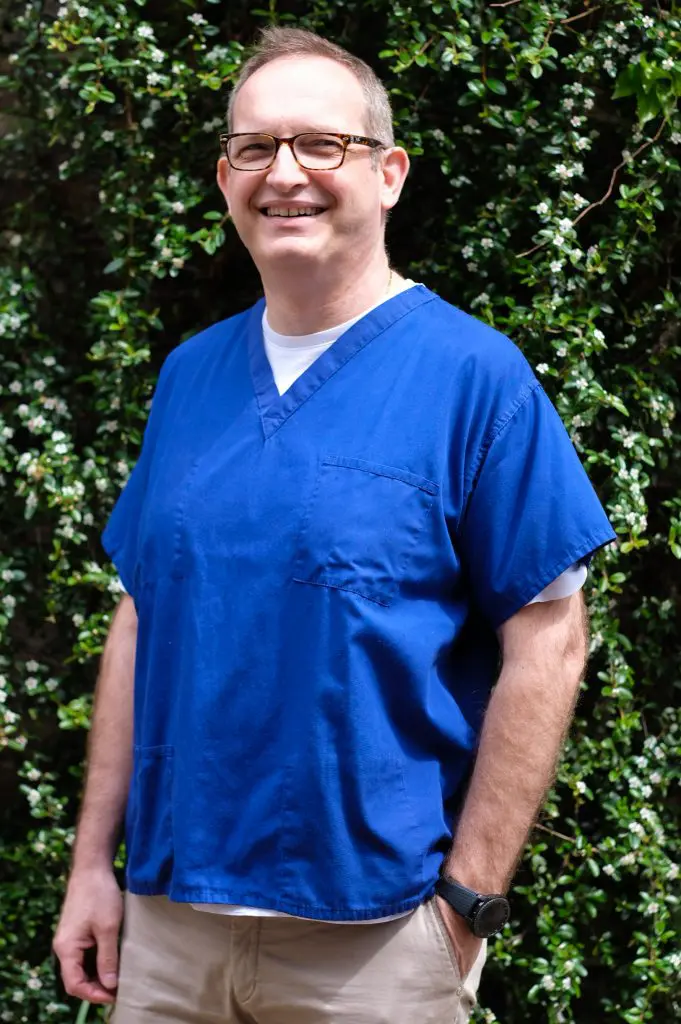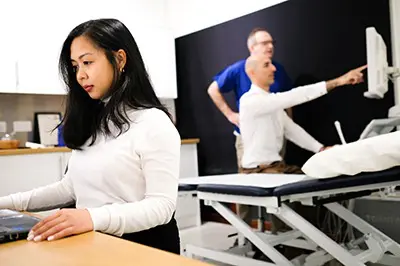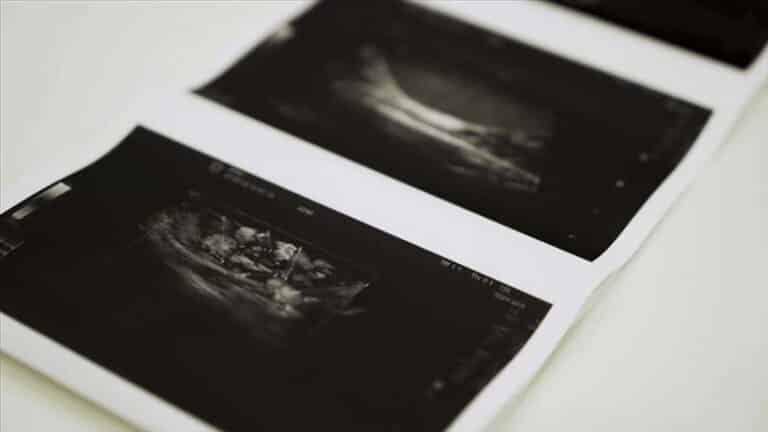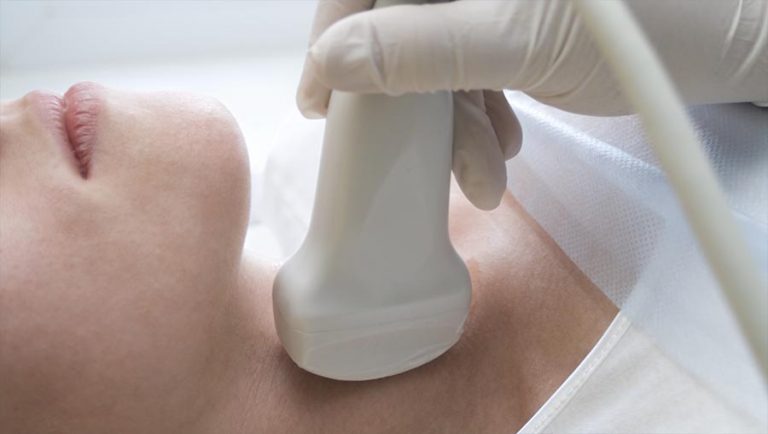What is the Thyroid?
The thyroid gland is the biggest gland in the neck. It is situated in the anterior (front) neck below the skin and muscle layers. The thyroid gland takes the shape of a butterfly with the two wings being represented by the left and right thyroid lobes which wrap around the trachea. The sole function of the thyroid is to make thyroid hormone. This hormone has an effect on nearly all tissues of the body where it increases cellular activity. The thyroid produces hormones that help your body to function properly. The thyroid gland absorbs iodine from the diet, which is found in fish, seafood and dairy products. It also produces two hormones; thyroxine (T4) and triiodothyronine (T3) which help keep the body functioning normally.
Ultrasounds is the first imaging modality being used to identify any thyroid abnormalities. The thyroid scan is one of our most popular investigations amongst the private ultrasound scans offered in our London ultrasound clinic.
Common Thyroid Problems
The thyroid gland is prone to several very distinct problems, some of which are extremely common. These problems can be broken down into [1] those concerning the production of a hormone (too much, or too little), [2] those due to increased growth of the thyroid causing compression of important neck structures or simply appearing as a mass in the neck, [3] the formation of nodules or lumps within the thyroid which are worrisome for the presence of thyroid cancer, and [4] those which are cancerous.
The information in this article is arranged to give you more detailed and complex information as you read further.
— Goiters ~ A thyroid goitre is a dramatic enlargement of the thyroid gland. Goitres are often removed because of cosmetic reasons or, more commonly because they compress other vital structures of the neck including the trachea and the oesophagus making breathing and swallowing difficult. Sometimes goitres will actually grow into the chest where they can cause trouble as well. Several nice x-rays will help explain all types of thyroid goitre problems.
— Thyroid Cancer ~ Thyroid cancer is a fairly common malignancy, however, the vast majority have excellent long term survival.
— Solitary Thyroid Nodules ~ There are several characteristics of solitary nodules of the thyroid which make them suspicious for malignancy. Although as many as 50% of the population will have a nodule somewhere in their thyroid, the overwhelming majority of these are benign. Occasionally, thyroid nodules can take on characteristics of malignancy and require either a needle biopsy or surgical excision.
— Hyperthyroidism ~ Hyperthyroidism means too much thyroid hormone. Current methods used for treating a hyperthyroid patient are radioactive iodine, anti-thyroid drugs, or surgery. Each method has advantages and disadvantages and is selected for individual patients. Many times the situation will suggest that all three methods are appropriate, while other circumstances will dictate a single best therapeutic option. Surgery is the least common treatment selected for hyperthyroidism. The different causes of hyperthyroidism are covered in detail.
— Hypothyroidism ~ Hypothyroidism means too little thyroid hormone and is a common problem. In fact, hypothyroidism is often present for a number of years before it is recognized and treated. There are several common causes, each of which are covered in detail. Hypothyroidism can even be associated with pregnancy. Treatment for all types of hypothyroidism is usually straightforward.
— Thyroiditis ~ Thyroiditis is an inflammatory process ongoing within the thyroid gland. Thyroiditis can present with a number of symptoms such as fever and pain, but it can also present as subtle findings of hypo or hyperthyroidism. There are a number of causes, some more common than others. Each is covered on this site.
Thyroid Cancer
In the UK, approximately 3000 people are diagnosed with thyroid cancer each year according to Cancer Research. It is a fairly rare type of cancer that develops slowly and is usually more common in middle-aged and older people. However, there is one type, known as papillary thyroid cancer, which often affects younger people. Overall, more women get thyroid cancer than men. It rarely affects children.
The four main types of thyroid cancer are:
Papillary Thyroid Cancer - Papillary cancer develops in the follicular cells and grows slowly. It is usually found in one lobe; only 10% to 20% of papillary cancers appear in both lobes.
Follicular Thyroid Cancer - Follicular cancer also develops in the follicular cells and grows slowly, yet is less common. When detected early, it can be treated successfully.
Papillary and follicular cancers makeup 80% to 90% of thyroid cancers, and are grouped under the term differentiated thyroid cancer. When detected early, especially in people below the age of 45-50 years, it can be treated successfully.
Medullary Thyroid Cancer - Medullary cancer develops in the C cells. It can be controlled if it is found and treated before it spreads to other parts of the body. Medullary cancer accounts for 5% to 10% of thyroid cancers.
Anaplastic Thyroid Cancer - This is a very rare and aggressive form of thyroid cancer that takes its origin from differentiated thyroid cancer or other benign tumours of the gland, and in its giant cell variety is often rapidly fatal.
The outlook for most types of thyroid cancer is usually very good, and many people are completely cured of the disease, even if it has spread beyond the thyroid.
As we well know, there are many kinds of cancer; unfortunately, they all come about because of the out-of-control growth of abnormal cells.
Healthy Cells vs. Cancer Cells
Healthy cells are like a cat. They need structure to determine the size of bones and shape of the body, tail and whiskers. The DNA in genes and chromosomes determine this. They need the energy to play and prowl and sustain life. This is derived from chemicals in food. Cats need a system to deliver chemicals (food nutrients like amino acids, carbohydrates, fats, vitamins and minerals) to all parts of their body. These are the blood vessels. Growth factors take a kitten into a lazy old cat, all the while helping it to function normally.
The body and its cells are mostly made up of protein. The building blocks of proteins are substances called amino acids that in the form of enzymes and hormones literally control every chemical reaction within the cells. When these are modified, different messages are sent to a complex control system that can alter their function. There are twenty different kinds of amino acids that are essential to life. Twelve of these can be synthesized within the body however; eight must be supplied by the daily diet.
Signs and Symptoms of Thyroid Cancer
The most common symptom of thyroid cancer is a lump or nodule, that can be felt in the thyroid gland or neck. Other symptoms are rare. Pain is seldom an early warning sign of thyroid cancer. You may have a tight or full feeling in the neck, difficulty breathing or swallowing, hoarseness or swollen lymph nodes.
Thyroid Ultrasound
The thyroid ultrasound scan will identify any lumps on the thyroid and will also check the overall appearance of the thyroid for evidence of thyroiditis.
International ultrasound services offers ultrasound scanning services in a central London location.
Content Information
We review all clinical content annually to ensure accuracy. If you notice any outdated information, please contact us at info@iuslondon.co.uk.
About the Author:

Yianni is a highly experienced sonographer with over 21 years in diagnostic imaging. He holds a Postgraduate Certificate in Medical Ultrasound from London South Bank University and is registered with the Health and Care Professions Council (HCPC: RA38415). Currently working at Barts Health NHS Trust, Yianni specialises in abdominal, gynaecological, and obstetric ultrasound. He is a member of the British Medical Ultrasound Society (BMUS), Society of Radiographers (SoR) and regularly contributes to sonographer and junior radiologists training programs.



